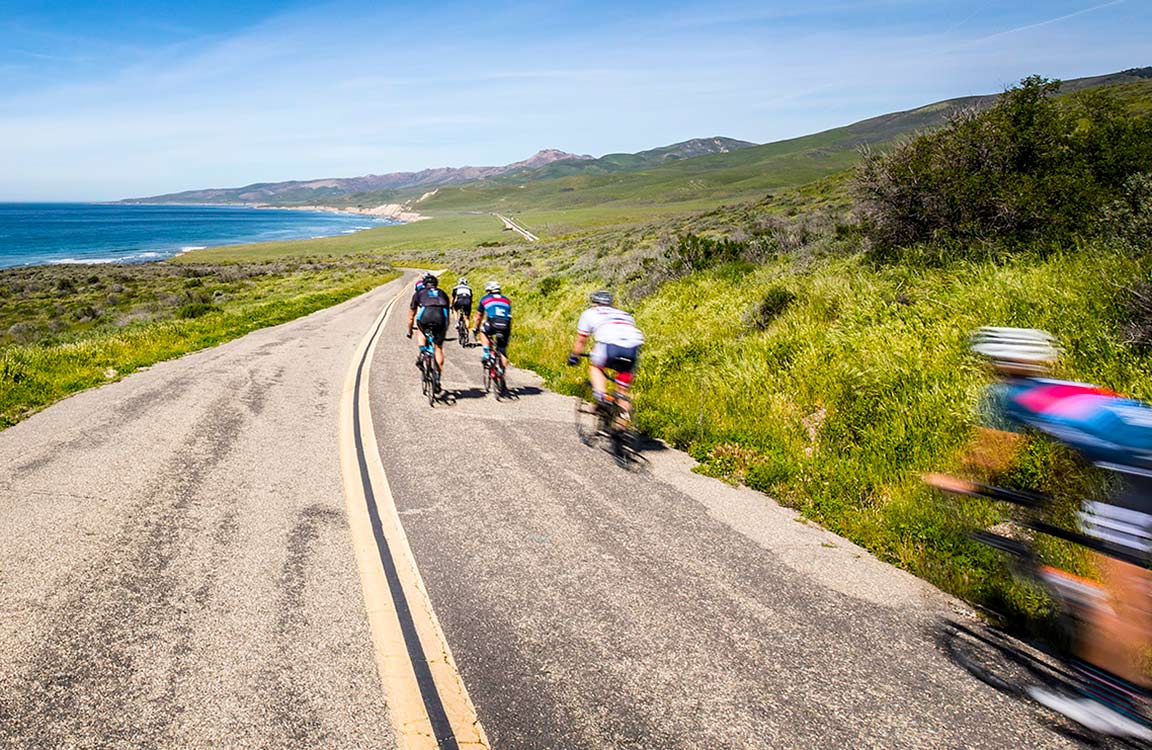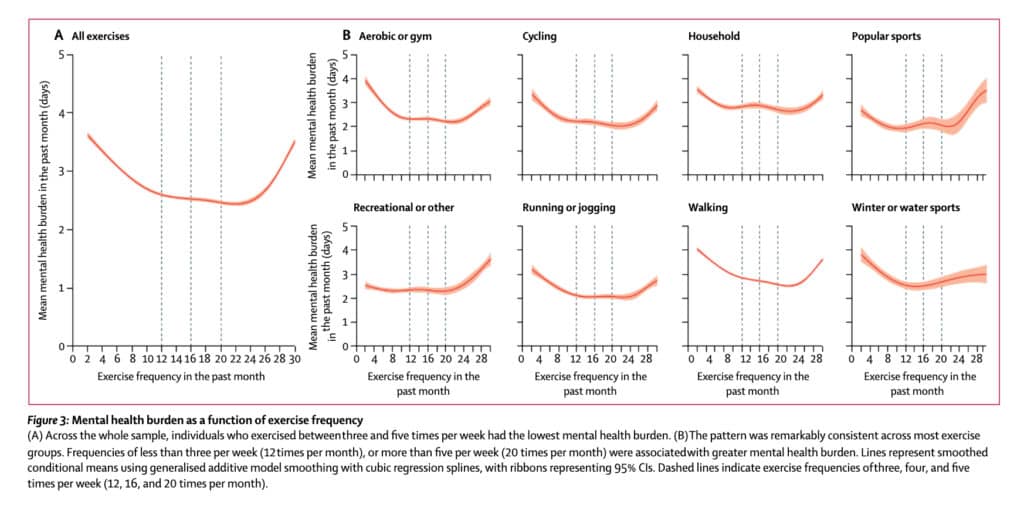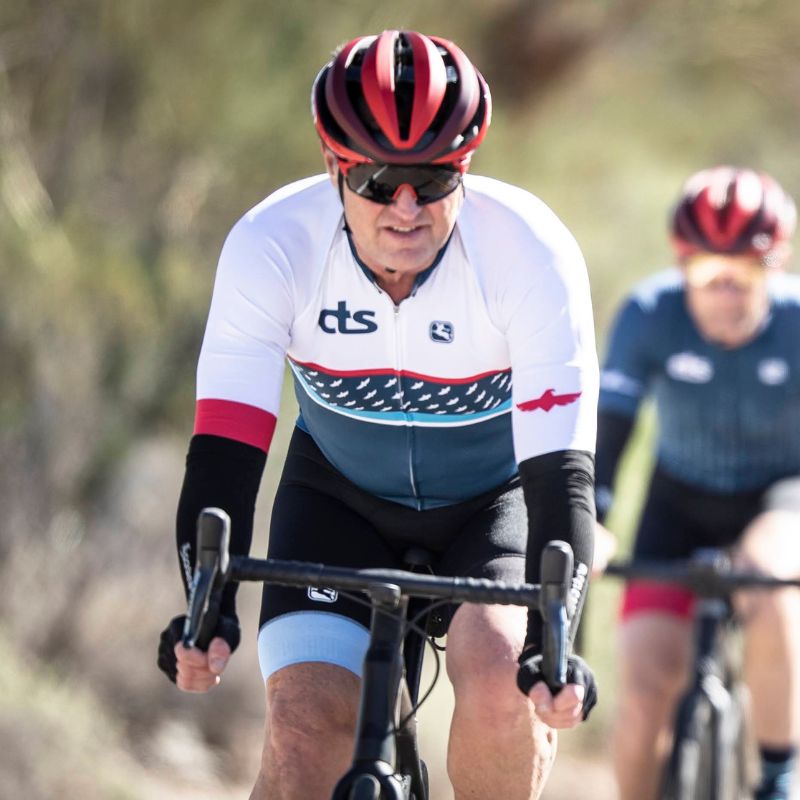
Mental Health: Exercise Only Goes So Far
By Chris Carmichael,
Founder and Head Coach of CTS
“Cycling keeps me sane.” We’ve all heard similar one-liners on group rides or social media posts, and there is plenty of evidence that exercise can play an important role in mental health. However, based on recent data and personal conversations with coaches and athletes throughout the pandemic, I think it’s time for more than one-liners.
According to a 2020 publication from the Centers for Disease Control and Prevention, the rate of suicide in the US increased by 35% between 1999 and 2018 (the most recent year they report). Notably, the rate increased 1% per year through 2006, and then accelerated to a 2% increase per year. During this period, the suicide rate for men was 3.7 times higher than for women. According to the National Institutes for Mental Health, men are more likely to die by suicide than women, but women are more likely to attempt suicide. Unfortunately, the suicide rate for women also increased 55% from 1999-2018. An earlier report from the CDC in 2018 indicated that the 45-64 age group experienced a 45% increase in suicide deaths between 2006-2016. The 2020 publication says the 45-64 age group has the highest suicide rate for women, but for men the rate is highest in the 75+ age group.
None of the aforementioned data includes suicides from 2020 during the pandemic and economic downturn. Survey data released by the CDC in August 2020 indicated an increase in the number of people who had seriously considered suicide in the previous 30 days, but experts caution it is much too early to know whether suicide mortality rates changed significantly in 2020. Suicidal ideation can be affected by innumerable factors, including genetics, relationships, education, environment, access to healthcare and mental healthcare, and many more. Exercise is almost always included in recommendations for people experiencing depressive moods or diagnosed depression, and it has protective qualities, but only to a point.
I think there is a fallacy prevalent among athletic, health-conscious populations that “It won’t happen to me.” It’s wonderful that cyclists knowingly use the bike to relieve stress and find joy, and that other athletes use physical activity the same way, but my growing concern–as a coach and not a mental health professional–is that athletes are overly confident in the protective qualities of exercise. “It” – whether that’s depression, suicidal ideation, or addiction – can happen to you.
Be realistic about exercise
Exercise can be helpful for dealing with stress and can elevate mood, but it does not replace therapy or medication in many cases. I absolutely believe a person’s physical conditioning – good or bad – can impact their outlook on life and their perception of self. Similarly, I believe nutrition affects mental health. However, no amount of exercise nor any combination of foods provides complete protection against (or treatment of) depression, addiction, or destructive coping mechanisms. In my view, anyone peddling an exercise-only or a nutrition/supplements-only “cure” for depression or addiction is overselling the impact of either.
Feel Stronger in 6 Weeks — No Matter Your Age
Climbs feel steeper? Recovery slower?
You’re not done getting faster — you just need a smarter plan.
The 6-Week Masters Power Build Coaching Program is designed for cyclists 50+ who want to boost power, recover faster, and ride stronger — all with expert 1:1 coaching.
- Personalized 6-Week Training Plan
- 1:1 Coaching + TrainingPeaks Premium
- Mobility & Strength Bonus Guides
💪 Guarantee: Stronger or free.
Start your 6-week journey for $149Seek help
The June 2018 Vital Signs report from the CDC noted that more than 50% of people who died from suicide had no diagnosed mental health condition at the time of death. Some of that may be attributable to the stigma around asking for help, particularly in the age groups with the highest rates: 45-64, and 75+.
Another important takeaway from the CDC reports is that not everyone who commits suicide is mentally ill. Successful, educated, affluent adults are often quick to dismiss suicide risk because, “I’m not mentally ill.” Unfortunately, acute stressors and easy access guns, prescription drugs, and alcohol too often lead to permanent solutions for temporary problems.
Talking to a healthcare professional would be ideal. If you’re uncomfortable with that, turn to a family member, coach, clergy member, training partner, or friend. Above all, talk to someone.
Practice self-care
This is where we get back to the bike. For many cyclists, riding is essential component of self-care. Solo rides can be restorative by providing time for yourself and distance (literal and figurative) from stressors in your life. Group rides can be energizing because they offer both physical challenge and social connections. The pandemic curtailed a lot of group rides and cancelled events, making it harder for cyclists to maintain those social connections. Interactive indoor cycling apps have helped, and after a period without group rides and events, athletes have a newfound appreciation for and eagerness to get back to in-person group activities when the pandemic subsides.
A 2018 study published in the journal Lancet Psychiatry examined data from the 2011, 2013, and 2015 Behavioral Risk Factor Surveillance System survey to see how sport type and exercise frequency, duration, and intensity influence the association between exercise and mental health. The 1.2 million respondents represented the general U.S. adult population, so the results are not specific to athletes or cyclists.
Not surprisingly, the study confirmed exercise reduced the number of days a person reported having “not good” mental health. Furthermore, they found exercising 45-60 minutes, 3-5 times per week, reduced people’s “mental burden” the most, as illustrated by the U-shaped lines in the figure below. The vertical dotted lines represent 3, 4, and 5 exercise sessions per week. However, adding even more exercise made mental burden go back up, potentially because of conflicts with other priorities or the physical strain relative to their fitness level.

Click image to expand. Source
Data from experienced, goal-oriented athletes might look a little different. You and I, for instance, may achieve the greatest reduction in mental burden with 90-120 minutes 4-6 times per week. There will be, however, a point of diminishing return, where adding more exercise will increase lifestyle stress rather than alleviate it.
► Free Cycling Training Assessment Quiz
Take our free 2-minute quiz to discover how effective your training is and get recommendations for how you can improve.
Other forms of self-care include:
- Getting adequate, high-quality sleep.
- Sustaining a daily meditation routine (even 10 minutes is good).
- Strengthening personal relationships.
- Scheduling restorative “down time”.
- Developing greater self-empathy.
A Coach’s Perspective
My philosophy and what I teach CTS Coaches is that everyone is an athlete, but we coach the whole person. The sport-specific part is important, but we spend more time talking about priorities, challenges, stressors, purpose, and values. I’ve seen the protective and restorative effects cycling can have on mental health. There’s no doubt it can have a positive impact. But there are issues a bike ride can’t solve, and it is critically important for athletes to seek help from mental health professionals and then utilize exercise as a component of treatment.
References
Chekroud, Sammi & Gueorguieva, Ralitza & Zheutlin, Amanda & Paulus, Martin & Krumholz, Harlan & Krystal, John & Chekroud, Adam. (2018). Association between physical exercise and mental health in 1·2 million individuals in the USA between 2011 and 2015: a cross-sectional study. The Lancet Psychiatry. 5. 10.1016/S2215-0366(18)30227-X.
Czeisler, Mark & Lane, Rashon & Petrosky, Emiko & Wiley, Joshua & Christensen, Aleta & Njai, Rashid & Weaver, Matthew & Robbins, Rebecca & Facer-Childs, Elise & Barger, Laura & Czeisler, Charles & Howard, Mark & Rajaratnam, Shantha. (2020). Mental Health, Substance Use, and Suicidal Ideation During the COVID-19 Pandemic – United States, June 24-30, 2020. MMWR. Morbidity and mortality weekly report. 69. 1049-1057. 10.15585/mmwr.mm6932a1.
“Suicide Rising across the US | VitalSigns | CDC.” Centers for Disease Control and Prevention, Centers for Disease Control and Prevention, 2018, www.cdc.gov/vitalsigns/suicide/index.html.
Griswold, Max G, et al. “Alcohol Use and Burden for 195 Countries and Territories, 1990–2016: a Systematic Analysis for the Global Burden of Disease Study 2016.” The Lancet, vol. 392, no. 10152, 2018, pp. 1015–1035., doi:10.1016/s0140-6736(18)31310-2.
Hedegaard H, Curtin SC, Warner M. Increase in suicide mortality in the United States, 1999–2018. NCHS Data Brief, no 362. Hyattsville, MD: National Center for Health Statistics. 2020.
► FREE Mini-Course: Learn How to Maximize Your Limited Training Time
Learn step-by-step how to overcome limited training time and get faster. Walk away with a personalized plan to increase your performance.
"*" indicates required fields


Comments 13
Very good article on a very interesting and important matter.
I would also love to know your oppinion on the iminence of the opposite.. the growing number of amateur athletes who struggle with their addiction to their sport and fitness in general, making them forget about their family, their carreer and anything else that is not related with their sport..
We can see this is many mid life adults, especially with the late surge of amateur competitions, like amateur races, sportives, Granfondos, and all this fitness hype these days.
I’m saying this out of personal experience, because sometimes a passion turns into an obssession and when we realise it, it might be too late to fix all those relationships and opportunities we left behind.
Cycling has helped me tremendously, both phisically and mentally thru the years. It has made me get to know the most amazing people and places, but it has also taken it’s toll on many other relationships and oportunities that are not directly related to it.
Finding a balance between your passion and your responsabilities isn’t easy when you love something so much, and especially when you are competitive, but it should be a main priority if we are to remain healthy and happy, wich was our objective, in the first place..
sorry Chris. i love your posts generally but i think this one is wading way outside your lane.
it’s one thing to remind people that exercise is not a complete shield or cure-all for mental health issues. but if you think it’s important to address these issues in depth – which i think is fine – you would do your readers a better service to have it done by a mental health professional.
Gene99: I hope you took the time to read this blog and not just the title. To start with we have over 60coaches and we have all seen first hand how this covid crisis has impacted our athlete’s mental health. So we are dealing with it everyday. Though out the blog I reccomend seeking help/support from a mental help professional. Here is a snapshot from my blog:
“I think there is a fallacy prevalent among athletic, health-conscious populations that “It won’t happen to me.” It’s wonderful that cyclists knowingly use the bike to relieve stress and find joy, and that other athletes use physical activity the same way, but my growing concern–as a coach and not a mental health professional–is that athletes are overly confident in the protective qualities of exercise. “It” – whether that’s depression, suicidal ideation, or addiction – can happen to you.” We clearly know that many times athletes think it can’t happen to them. I am blogging about this because we are hearing from our many, many athletes everyday that many of them feel their mental health is impaired because everything related to the covid crisis.
All the best and I’m in my lane and plan to stay there. Thank you.
Chris Carmichael
Just when you think Chris couldn’t be a more common sense big picture person he goes and does this. Way to coach life and not just cycling. Why I have been a fan for years. Thanks Chris.
Check out Go4Graham. They do great work. Their mission is to shred the stigma surrounding mental health and to promote mental wellness through exercise, community and education.
Go4Graham has built a grassroots community of 2000+ like minded individuals who share a common passion: believing that community and physical activity are crucial for the treatment of mental illness. While our community is well represented by some pretty amazing athletes (a lot of cyclists, runners, skiers, snowboarders, climbers, yogis, cross-fitters, triathletes, climbers… the list goes on), we also know that any type (or intensity) of movement is beneficial in improving mental health outcomes
Mr. Carmichael, thx for sharing. As you mentioned that not all suicides are linked to mental health issues, please consider the opposite statement as well: not all mental health issues lead to suicide. Illustrating mental health issues with suïcide statistics may make the topic of mental illness more of a dark thought and less likely to be discussed openly.
Frank: yes I like your statement and agree that is a better approach.
Chris
As a life-long Bipolar Schizophrenic I can only add two additional thoughts. I am 70 years old and for most of my life mental health issues have been avoided at all costs by much of society. Even some of the doctors I have seen over the years have made mental health an avoided topic.
I have been an endurance athlete since the age of 14 when I was introduced to cross country running. I immediately found that things calmed down for me after a good hard run, bike ride or swim. For many years these were my medications because I could not convince a doctor that there may be help in the form of drugs. About 10 years ago I found a Psychiatrist who immediately saw my conditions for what they are and my life has improved dramatically! So be sure to tell your readers that they must be diligent and very persistent when seeking medical help. It also helps to understand as much as possible about one’s condition so a quality conversation my be had with a doctor!
Finally, and my second point, don’t hide your condition. I’ve often said to folks on a group rides that I’ve been known to grab the wheel in front of me only to realize there is no one there! So I tell folks if I take off like a bat out of hell for no apparent reason to ride up touch my shoulder and say my name. Usually I see that guy ahead of me disappear and things go back to normal. Then we all have a great conversation about my crazy afflictions at the Taco place after the ride! We laugh about the fact that I seem to have a personal lead out man who shows up at the county line.
Clint:
I appreciate your transparency on this topic and glad cycling/exercising has helped you. Congrats on your path forward.
All the best, Chris
Thanks for sharing your story. Hope rides are great.
Chris, thank you for writing these excellent points on this very important topic. I would also add that we need to be overtly and actively supportive of others who have loved ones who experience mental health issues and suicide. Societal stigma is one of the strongest factors deterring people from seeking help and further isolates those who need help. And for those who have lost loved ones to suicide, the stigma greatly increases the burden of grief. Those of us who do not directly suffer from mental health challenges owe it to the rest of our friends, families and society to be actively supportive.
Thank you for your response as I agree that the stigmatism is huge for those who feel they will be judged or looked at differently by friends, co-workers or family if they ‘seek’ help. It’s so important people know it’s ok to seek help! Makes us human not ‘crazy’ or whatever term people may use. Feeling depressed? Please seek help! ❤️
Hi Chris – I’m an avid cyclist and a clinical psychologist and your article is spot-on. For so long, athletes and especially men, have neglected to take their mental health seriously. I have also seen my cyclist friend get into a somewhat obsessive relationship with their cycling/exercise as a way to avoid dealing with mental health issues. Thank you for using this platform to bring attention to this important issue! Cycling is a huge part of my own self-care, but so is therapy, meditation, social connection with family and friends, etc – we are whole persons…not just athletes : )